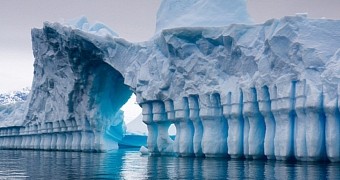Having analyzed 19 years' worth of data concerning sea level rise around Antarctica, a team of scientists have found that this southernmost continent is being engulfed by water at a faster rate than all other patches of land in the world.
Thus, specialists say that, according to the satellite data they compiled and analyzed, sea level rise around the coast of Antarctica over the past 19 years was one of 8 centimeters (about 3.15 inches).
By comparison, average sea level rise documented on a global scale during the same period was one of just 6 centimeters (2.36 inches), the University of Southampton in the UK researchers behind this investigation say.
In a paper in the journal Nature Geoscience, the specialists explain that melting glaciers are the ones to blame for the fact that sea level around Antarctica is rising at a surprisingly rapid pace when compared to other coastlines.
More precisely, evidence obtained with the help of satellites indicates that water resulting from melting glaciers in this part of the world is toying with the local sea level by altering the anatomy and the salinity of the ocean.
This theory is backed up by the outcome of a computer simulation documenting the effect of a constant freshwater flow originating from glaciers on sea level around the coast of Antarctica, the Alpha Galileo Foundation informs.
“Freshwater is less dense than salt water and so in regions where an excess of freshwater has accumulated we expect a localized rise in sea level,” University of Southampton researcher and study lead author Craig Rye said in a statement.
“The computer model supports our theory that the sea-level rise we see in our satellite data is almost entirely caused by freshening (a reduction in the salinity of the water) from the melting of the ice sheet and its fringing ice shelves,” the scientist went on to add.
It is estimated that, over the course of the 19 years that this research project focused on, glaciers dumped somewhere around 350 gigatonnes of freshwater in the ocean around the coast of Antarctica. Should these glaciers continue to melt, local sea level will continue to up.
Specialists warn that these changes in the makeup of the ocean surrounding Antarctica are likely to alter not just local ecosystems, but also global marine ecosystems. This is because bottom water in this part of the world interacts with other oceans covering our planet's surface.
As specialist Graig Rye put it, “The interaction between air, sea and ice in these seas is central to the stability of the Antarctic Ice Sheet and global sea levels, as well as other environmental processes, such as the generation of Antarctic bottom water, which cools and ventilates much of the global ocean abyss.”

 14 DAY TRIAL //
14 DAY TRIAL //